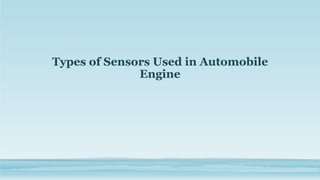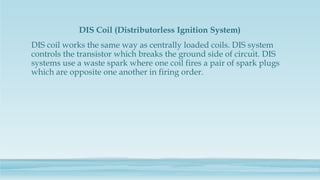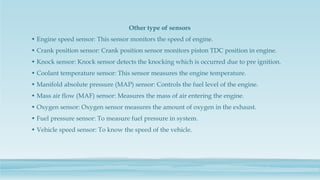Types of Sensors Used in Automobile Engine
- 1. Types of Sensors Used in Automobile Engine
- 2. Modern day automobile engines are made of many electronic and electrical components that constitute engine sensors, relays and actuators. All these electronic and electrical components work together to provide Engine Control Unit (ECU) with vital data required to govern the engine functionality effectively. Sensors send the information in very less time. Sensors used in engine are generally electro-mechanical type devices that monitor various engine parameters.
- 3. Delta Pressure Feedback EGR sensor (DPFE sensor) EGR stands for Exhaust Gas Recirculation. The system mechanism involves sucking of exhaust gases back into the engine to re-burn them. DPFE sensor reads the changes in the pressure of the EGR system. A vacuum line comes off the intake manifold to EGR actuator. The actuator is an electric device which is controlled by power-train control module (PCM) that monitors the vacuum pressure. From here, another hose goes to the EGR valve. When vacuum pressure opens the EGR valve, letting exhaust gases to be pulled from the exhaust, past the DPEF tubes, and then again into exhaust manifold. When the gas flows from EGR tube, the two tubes towards the DPEF sensor get pressurized. There is a difference in pressure, where one of the tubes has more pressure than the other. DPEF registers the pressure difference and tells the amount of exhaust gas flowing through EGR.
- 4. Throttle position sensor (TPS) Throttle shaft is attached with a potentiometer called TPS. This sensor is supplied with voltage and a voltage of varying current comes back. The voltage increases as the throttle opens. This variable voltage and the MAP sensor determines the amount of air which enters into the engine. This results in increase or decrease of the fuel rate as required.
- 5. Cam position sensor Cam position sensor monitors the position of camshaft and reports data to ECU. The data from the cam position sensor is used by the fuel injectors in engine and fire accordingly. This sensors is coupled with crankshaft position sensor.
- 6. Ignition control module Ignition control module controls the ignition coil's firing time. It is the heart of an automobile ignition system. It regulates spark ignition from inside the engine. It is dependent on the battery of automobile for spark, that begins the ignition system. Ignition control module is placed near automobile distributor and is insulated to protect its electronic components.
- 7. DIS Coil (Distributorless Ignition System) DIS coil works the same way as centrally loaded coils. DIS system controls the transistor which breaks the ground side of circuit. DIS systems use a waste spark where one coil fires a pair of spark plugs which are opposite one another in firing order.
- 8. Other type of sensors • Engine speed sensor: This sensor monitors the speed of engine. • Crank position sensor: Crank position sensor monitors piston TDC position in engine. • Knock sensor: Knock sensor detects the knocking which is occurred due to pre ignition. • Coolant temperature sensor: This sensor measures the engine temperature. • Manifold absolute pressure (MAP) sensor: Controls the fuel level of the engine. • Mass air flow (MAF) sensor: Measures the mass of air entering the engine. • Oxygen sensor: Oxygen sensor measures the amount of oxygen in the exhaust. • Fuel pressure sensor: To measure fuel pressure in system. • Vehicle speed sensor: To know the speed of the vehicle.
- 9. Sensors are very time sensitive and share information very fast. Hence having a good sensor results in better and safer automobile.
- 10. Airtex Fuel Delivery Systems is the leading aftermarket supplier of mechanical and electric fuel pumps and modular reservoir assemblies (MRA). For over 50 years, the Airtex brand has been the benchmark of fuel delivery and cooling system components. Airtex fuel pump is an OE replacement pump. Airtex electric fuel pump and mechanical pump models are available for old and new cars.









